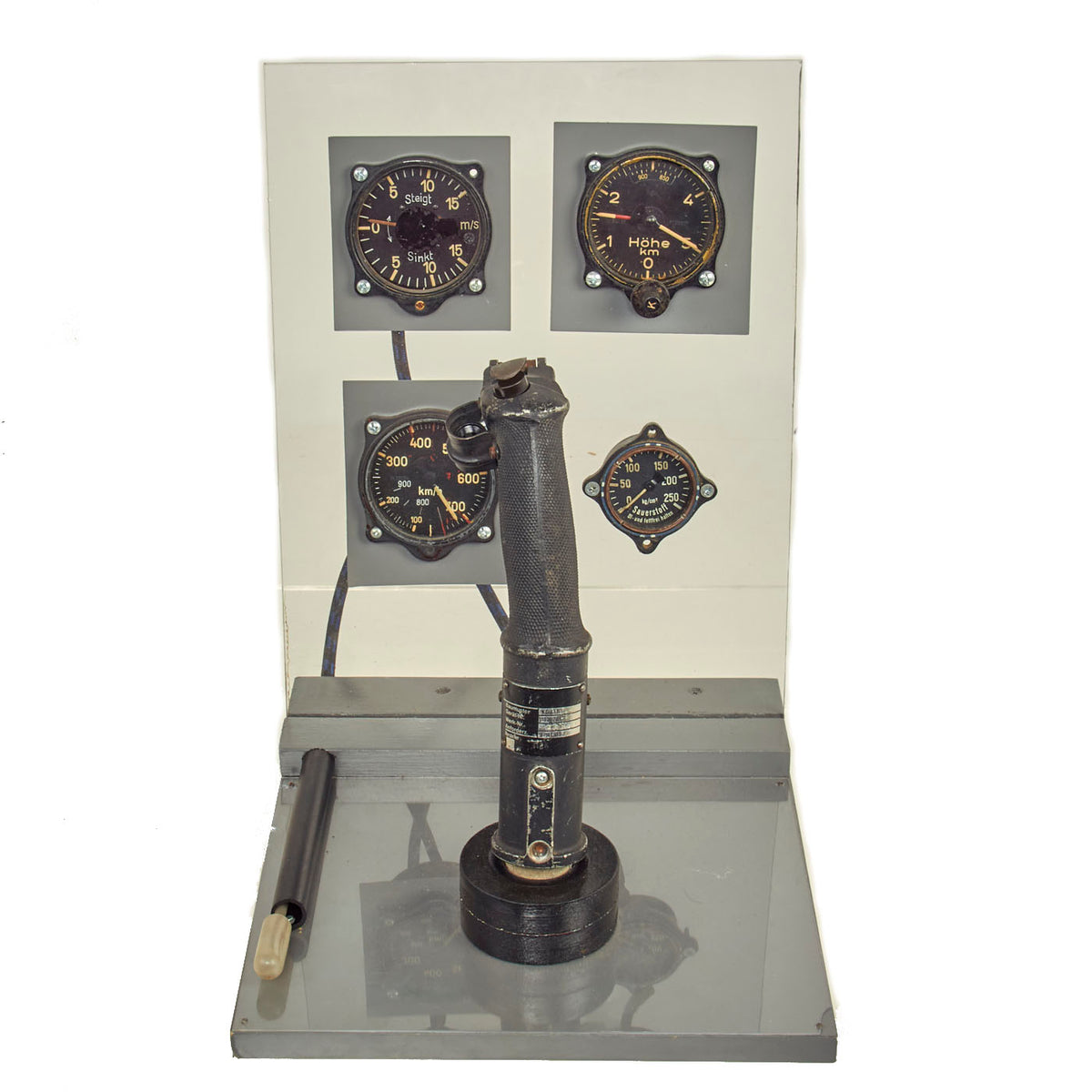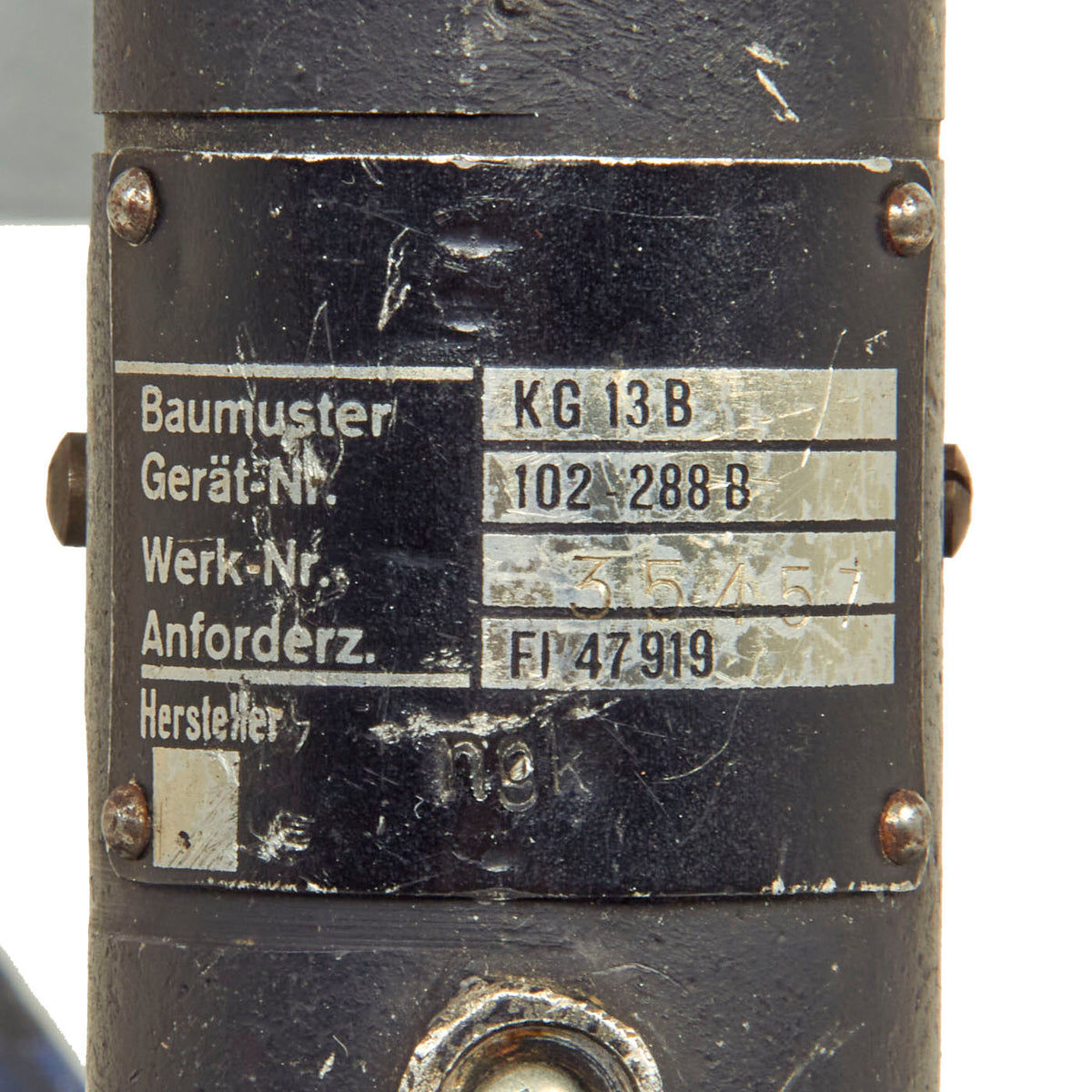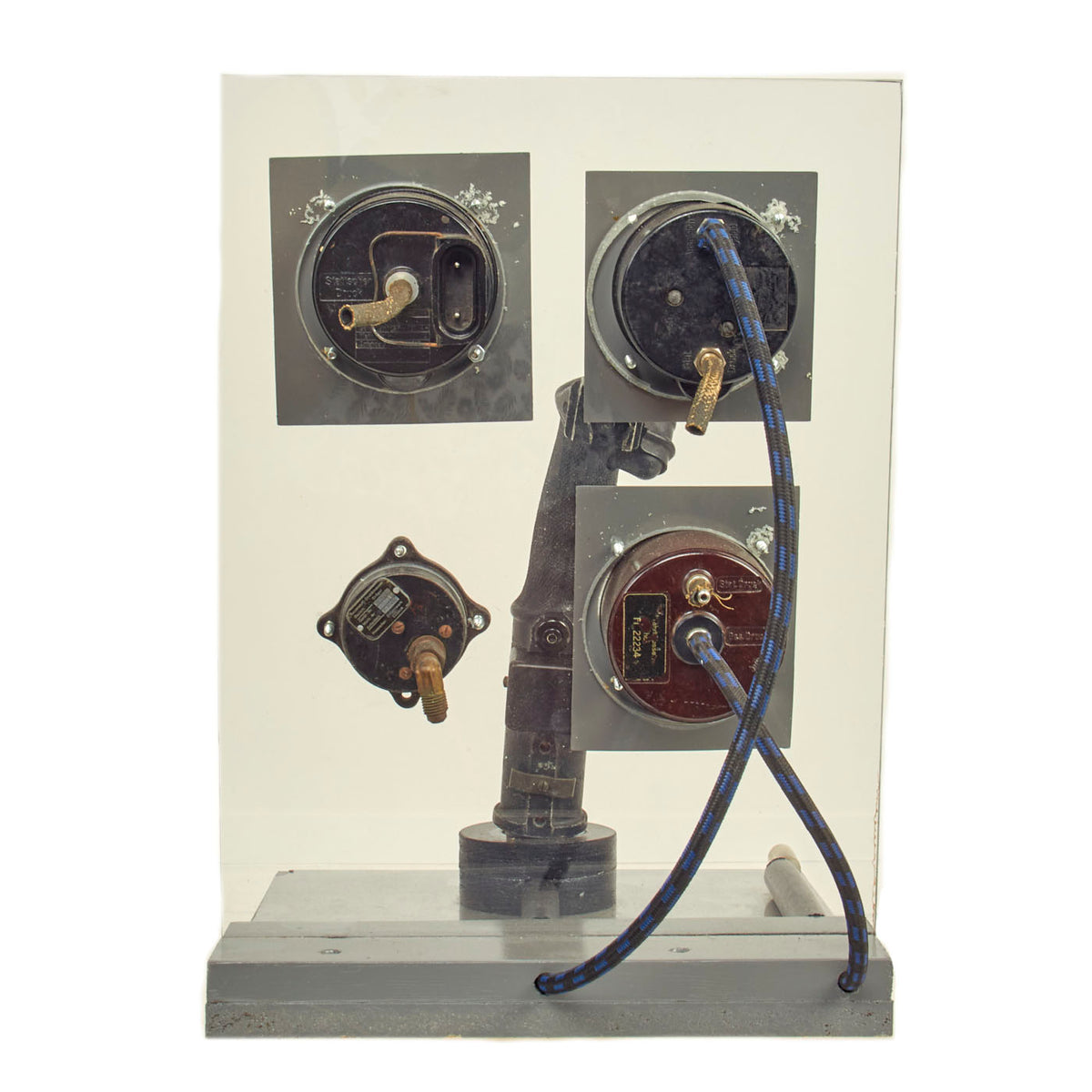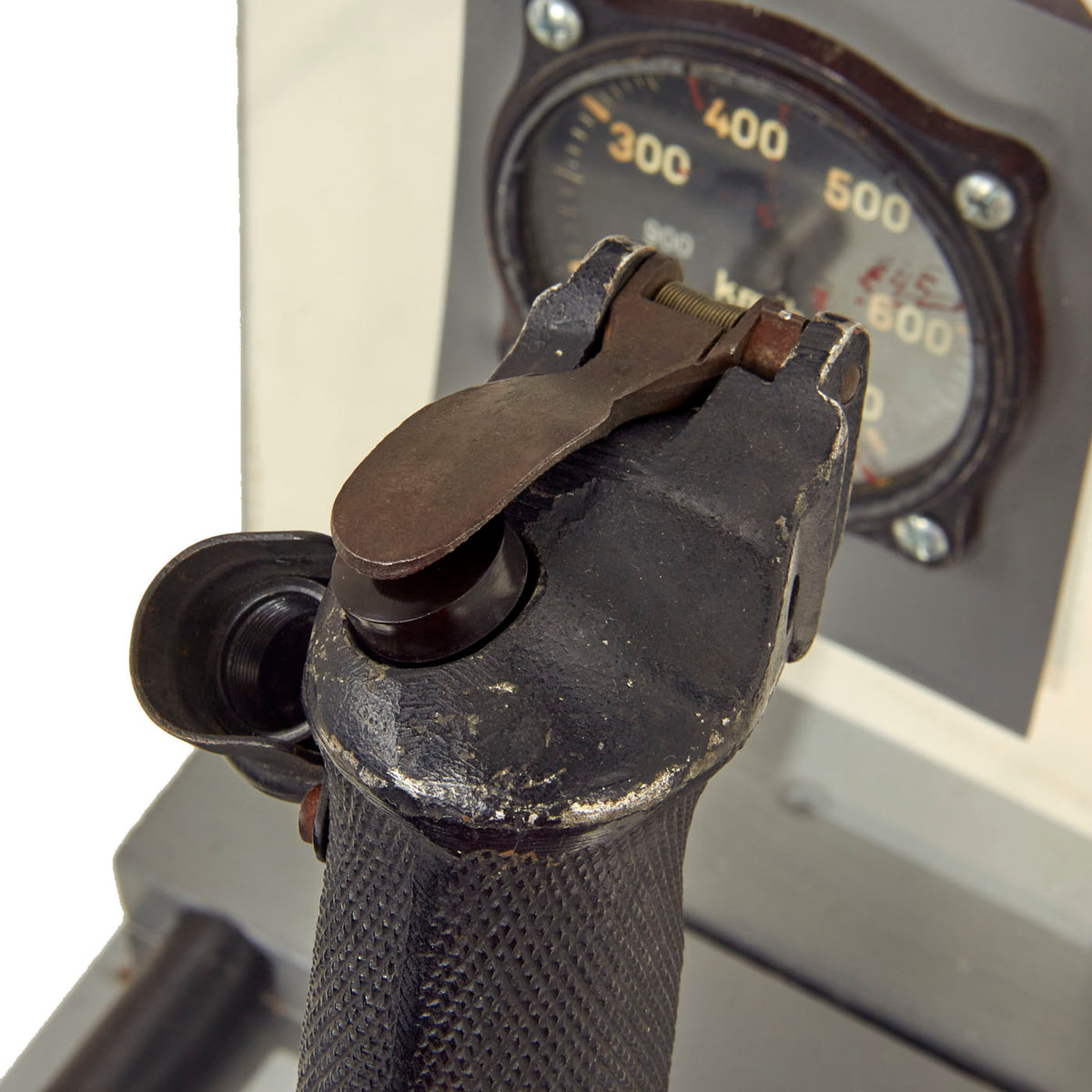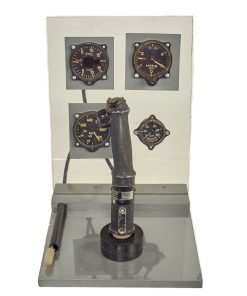Original German WWII Luftwaffe ME109 Messerschmitt Bf 109 Control Stick KG12E with Instrument Panel Gauges – Functional Display Original Items
$ 5.995,00 $ 1.498,75
Original Items: Only Ones Available. An absolutely FANTASTIC display perfect for the Luftwaffe, Aviation, or General WWII collector! This set consists of an original ME109 Control Stick and four gauges made into a semi-functional display!
The display has been assembled with a plexiglass topped painted wooden base, with a plexiglass backboard to which four gauges have been mounted. The most exciting aspect of this display is that whoever created it, did so that the Airspeed Indicator Gauge can be manipulated by squeezing an air bladder mounted to the left of the control stick on the base. By squeezing the bladder, the Airspeed Indicator Gauge dial can move ¾ around the gauge face! In addition, if slight downward pressure is applied while moving the Control Stick, the movement manipulates the Variometer (Vertical Speed Indicator) to move up or down!
Items mounted on the display consist of:
KG13B ME-109 Control Stick: This is an incredibly rare Messerschmitt Bf 109 Control Stick, complete with machine gun flip down trigger! This particular model is a KG13B. The Geraete-Nummer is 102-288 B. The letter “B” was stamped into the data plate and was the designation for the sub-type of the KG13, obviously the KG13B. Fl.-Nr. 47919. Features a B2-button (missing) which the KG13 has at the top left, plus a top trigger and push button. The KG13B was used multiple airplanes including the Me 109 E, Ju 87 B and other aircraft. There is also an ordnance code stamped on the front and back of the stick ngk, which stands for the firm of Luftfahrt-Apparatebau GmbH, Berlin.This example is offered in very good condition.
100-900 km/h Fahrtmesser (Airspeed Indicator) Guage, FL 22234: In original bakelite housing. Currently rigged to allow the hands to move when air is pumped into the gauge using the original aperture.
Rate of Climb Indicator/ Vertical Speed Indicator 15 M/S Variometer Fl 22386 In original bakelite housing. Currently rigged to allow movement of the Control Stick to manipulate the hand of the indicator up or down.
Altimeter Gauge, Hohe KM Statischer Druck, F22317. Ordnance Code Marked hgo. In original bakelite housing. Hands and internal dial move when the dual stems are turned.
Oxygen Flow Gauge, Sauerstoff FL30496 In original bakelite housing with dataplate on reverse.
The display measures 11 ¾” x 12 ¾” x 16 ½”. A truly rare and wonderful piece of WW2 aviation history!
The ME-109:
The Messerschmitt Bf 109, was a German World War II fighter aircraft that was the backbone of the Luftwaffe’s fighter force. The Bf 109 first saw operational service during the Spanish Civil War (1939) and was still in service at the dawn of the jet age at the end of World War II (1945). It was one of the most advanced fighters of the era, including such features as all-metal monocoque construction, a closed canopy, and retractable landing gear. It was powered by a liquid-cooled, inverted-V12 aero engine. From the end of 1941, the Bf 109 was steadily being supplemented by the superior Focke-Wulf Fw 190.
It was commonly called the Me 109 most often by Allied aircrew and even amongst the German aces themselves even though this was not the official German designation. The “Bf 109” designation was issued by the German ministry of aviation and represents the developing company Bayerische Flugzeugwerke and is a rather arbitrary figure.
It was designed by Willy Messerschmitt (hence Me 109) and Robert Lusser, who worked at Bayerische Flugzeugwerke, during the early to mid-1930s.
Originally conceived as an interceptor, later models were developed to fulfill multiple tasks, serving as bomber escort, fighter-bomber, day-, night-, all-weather fighter, ground-attack aircraft, and as reconnaissance aircraft. It was supplied to and operated by several states during World War II, and served with several countries for many years after the war. The Bf 109 was the most produced fighter aircraft in history, with a total of 33,984 airframes produced from 1936 up to April 1945.
The Bf 109 was flown by the three top-scoring German fighter aces of World War II, who claimed 928 victories among them while flying with Jagdgeschwader 52, mainly on the Eastern Front. The highest scoring fighter ace of all time, Erich Hartmann, flew the Bf 109 and was credited with 352 aerial victories. The aircraft was also flown by Hans-Joachim Marseille, the highest scoring German ace in the North African Campaign who achieved 158 aerial victories. It was also flown by several other aces from Germany’s allies, notably Finn Ilmari Juutilainen, the highest scoring non-German ace on the type, and pilots from Italy, Romania, Croatia, Bulgaria and Hungary. Through constant development, the Bf 109 remained competitive with the latest Allied fighter aircraft until the end of the war.
Fast Shipping with Professional Packaging
Thanks to our longstanding association with UPS FedEx DHL, and other major international carriers, we are able to provide a range of shipping options. Our warehouse staff is expertly trained and will wrap your products according to our exact and precise specifications. Prior to shipping, your goods will be thoroughly examined and securely secured. We ship to thousands clients each day across multiple countries. This shows how we're dedicated to be the largest retailer on the internet. Warehouses and distribution centres can be located throughout Europe as well as the USA.
Note: Orders with more than one item will be assigned a processing date depending on the item.
Before shipping before shipping, we'll conduct a thorough inspection of the items you have ordered. Today, the majority of orders will be delivered within 48 hours. The delivery time will be between 3-7 days.
Returns
The stock is dynamic and we cannot completely manage it because multiple stakeholders are involved, including our factory and warehouse. So the actual stock may alter at any time. It's possible that you may not receive your order once the order has been made.
Our policy is valid for a period of 30 days. If you don't receive the product within 30 days, we are not able to issue a refund or an exchange.
You can only return an item if it is unused and in the same state as the day you received it. You must have the item in its original packaging.
Related products
Uncategorized
Angolan Rebel 1970s era 60mm Inert Display Mortar from Angolan Civil War Original Items
Uncategorized
Uncategorized
Armored Burgonet Helmet & Polearm from Scottish Castle Leith Hall Circa 1700 Original Items
Uncategorized
Uncategorized
Uncategorized
Uncategorized
Uncategorized
Uncategorized
Uncategorized
Uncategorized
Uncategorized
Uncategorized
Uncategorized
Uncategorized
Uncategorized
Uncategorized
Uncategorized
